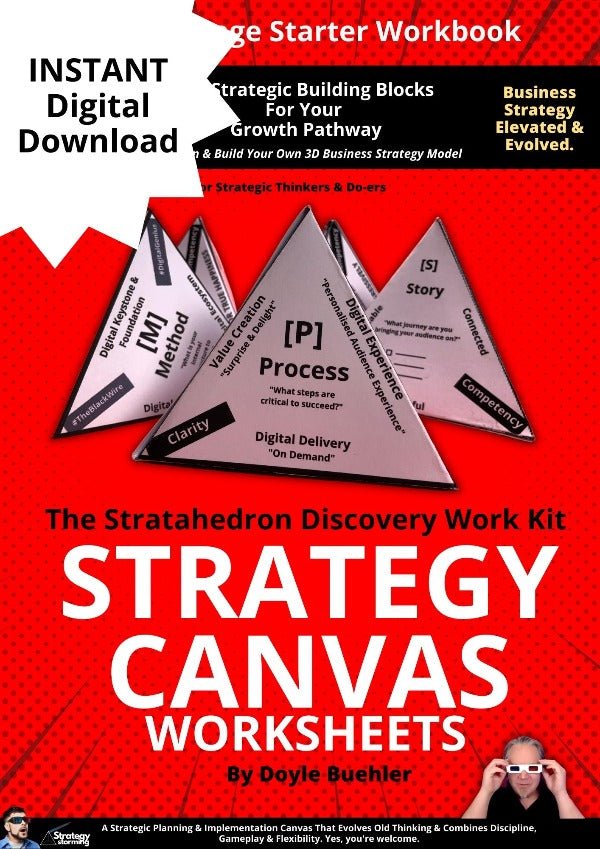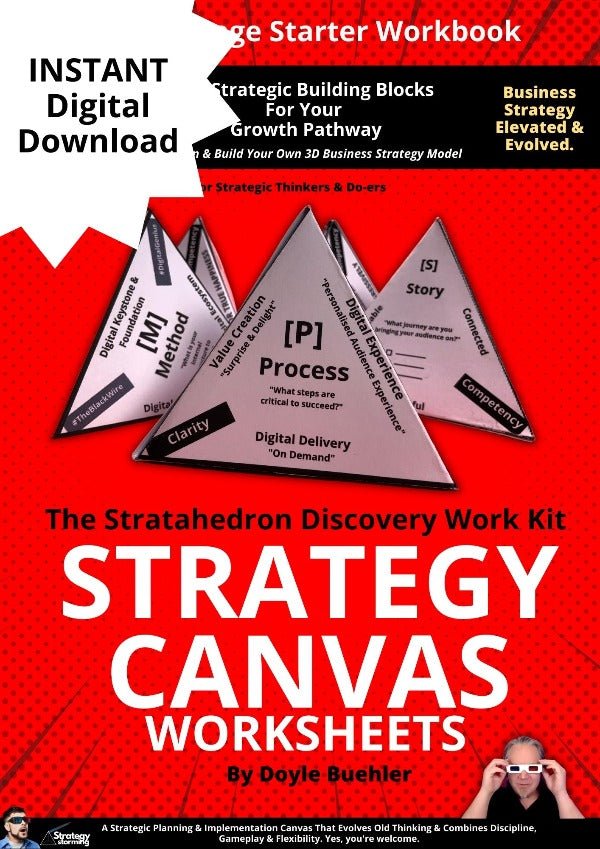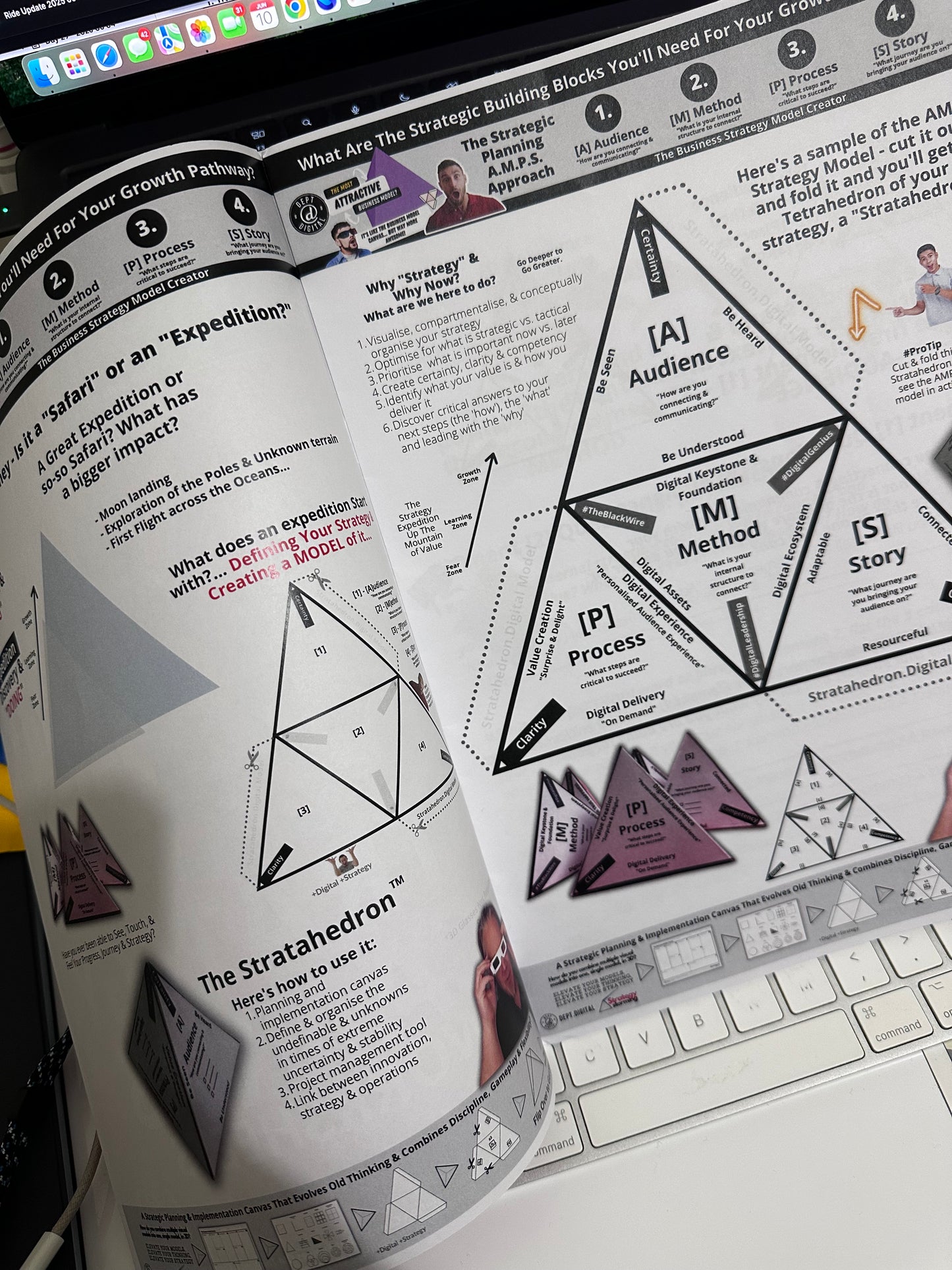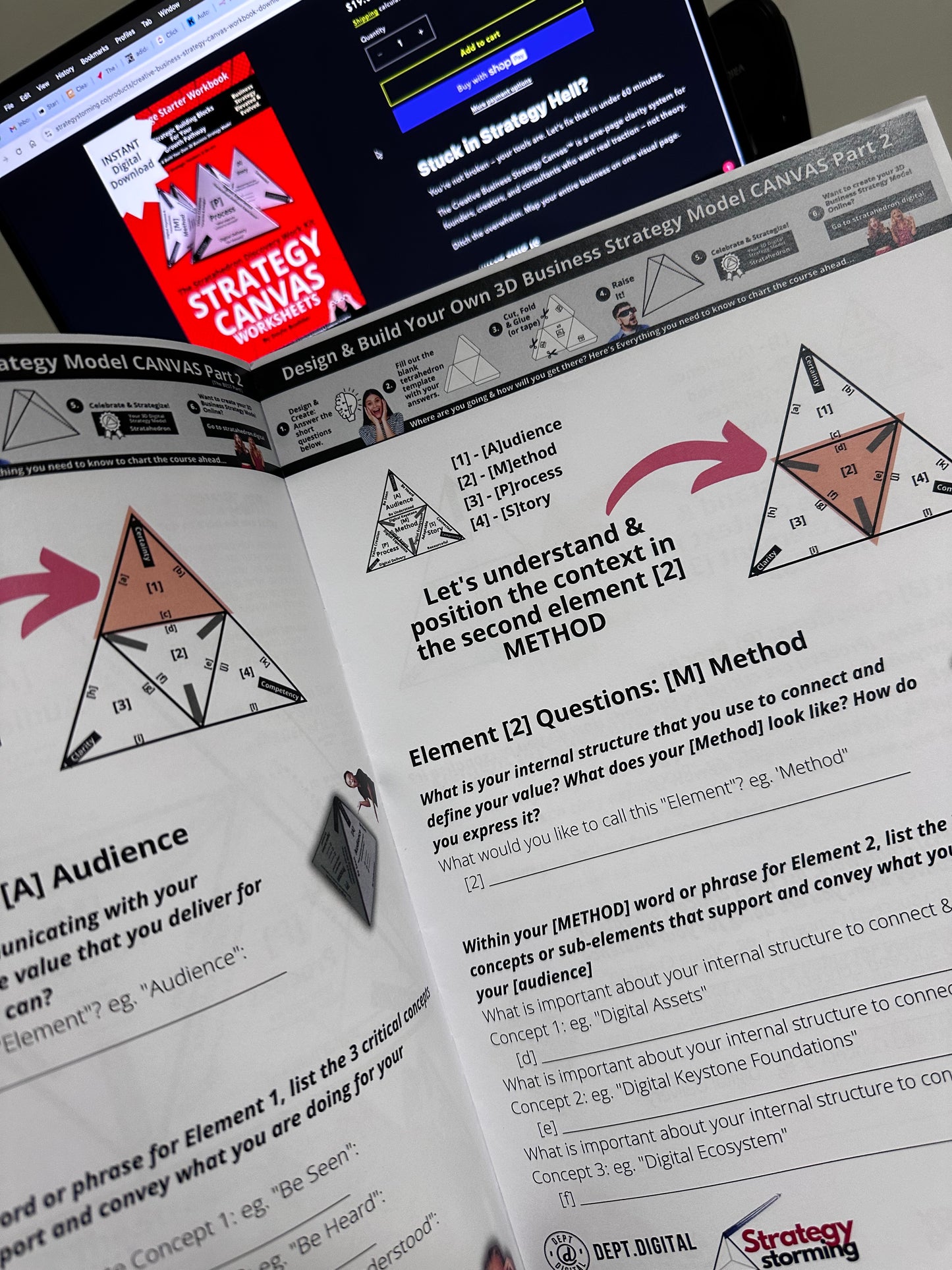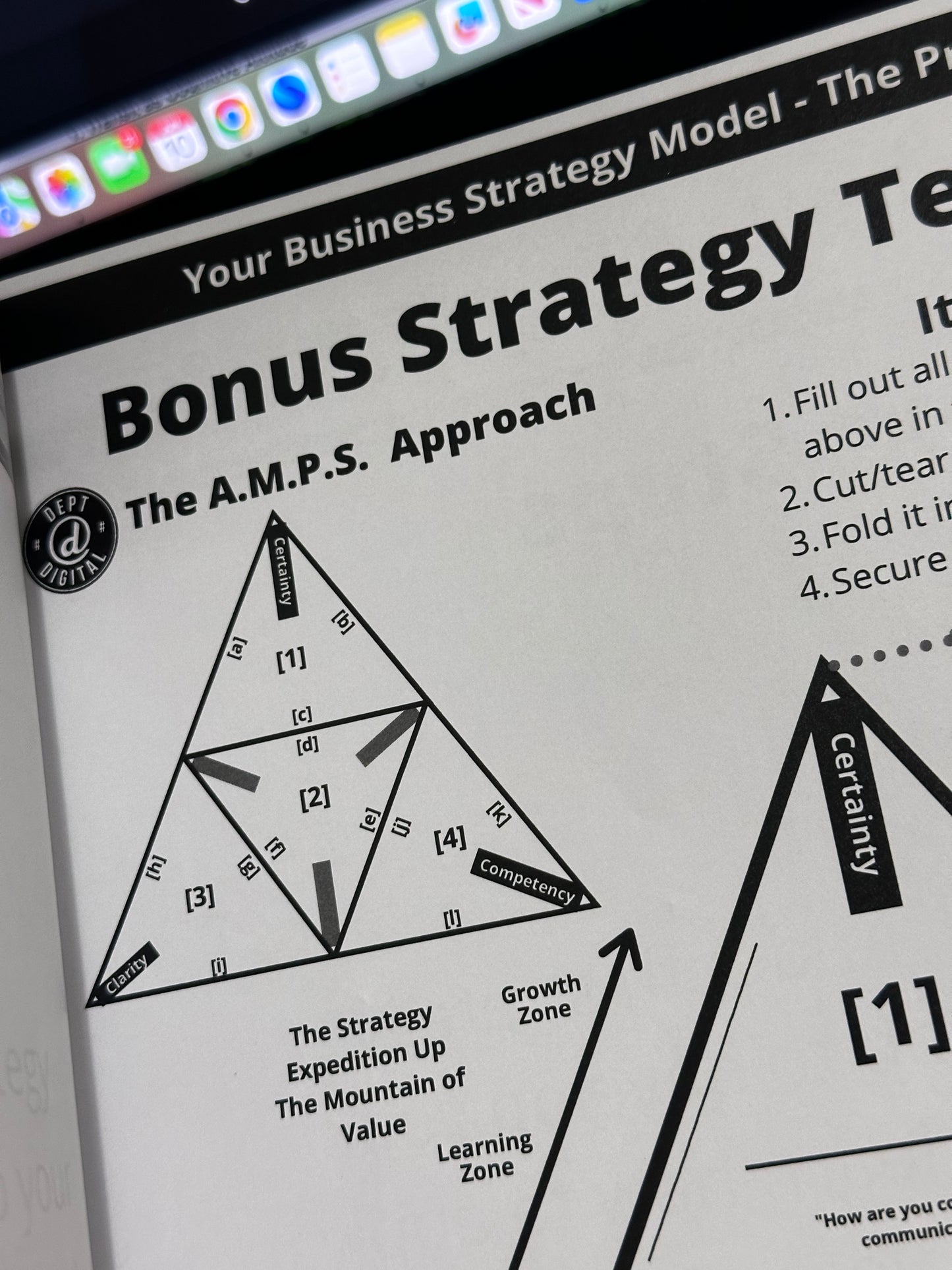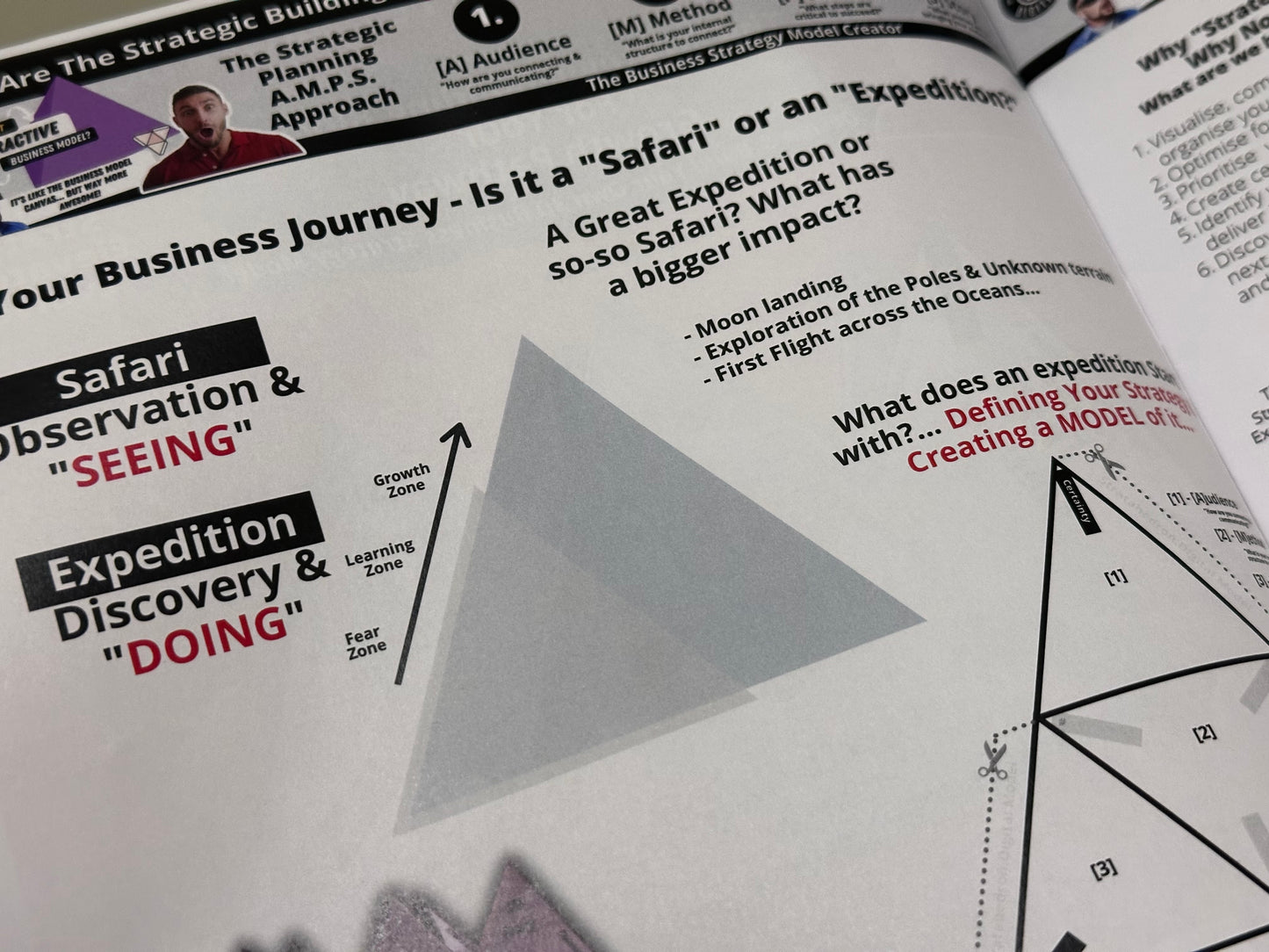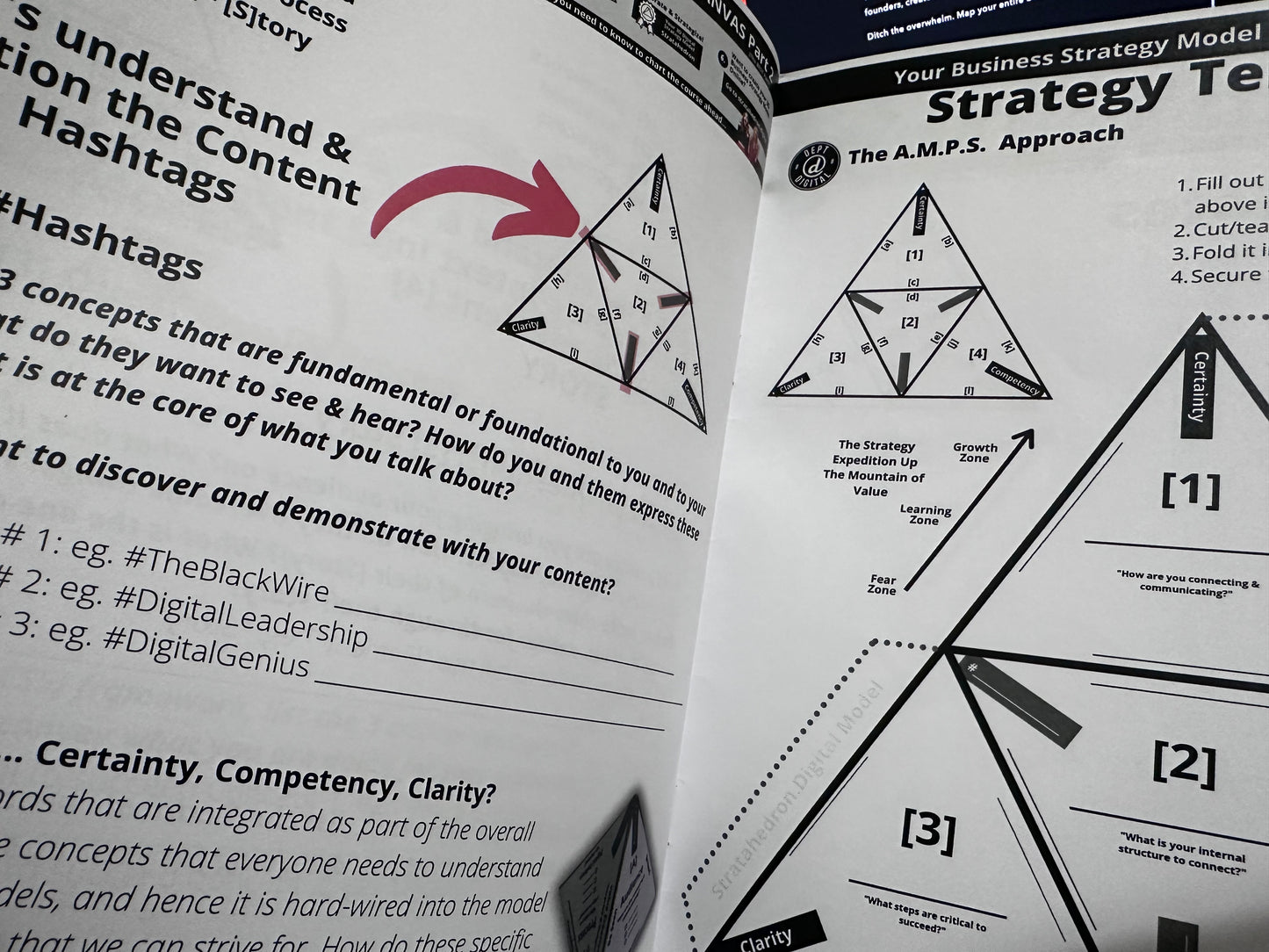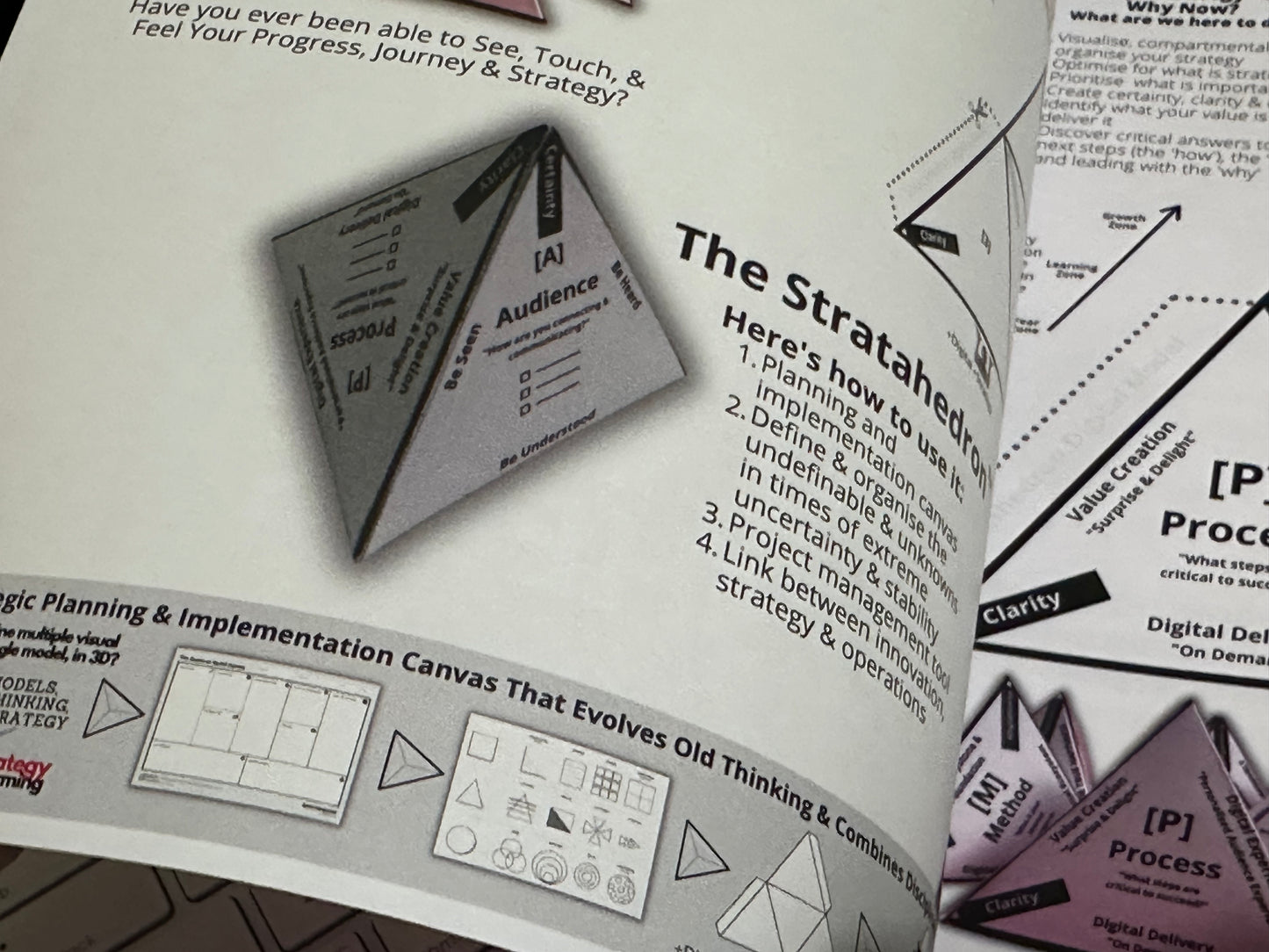
4 Strategic Steps to Rethink and Reimagine SWOT Analysis for Your Business
Share
What's your Strategy SuperModels? - SWOT Analysis Reimagined + Salesforce SWOT
Unlock Your Business Potential with Strategic SWOT Models—Dive in Now to Transform How You See Strategy with your own SWOT Analysis Worksheet
Here's some SWOT tools that will help you reinvent how you see your business and strategy
What does your SWOT Analysis really look like? Can you make it different than all the rest? It's an old and tired model.
Let's reinvent the SWOT model. This is an in-depth look into "Strategy SuperModels," specifically focusing on a reimagined version of the traditional SWOT (Strengths, Weaknesses, Opportunities, Threats) analysis.
Get your Free SWOT Strategic Analysis Tool Here.
Here's how to rethink and reimagine SWOT for your business
What to know how to Reimagine & Customize your SWOT Analysis?
In a highly engaging format, the video walks the audience through a new 3D model, "The Stratahedron," and applies it to brand strategy. It also features a real-world example, doing a SWOT analysis of Salesforce to demonstrate its utility. The video is interactive, offering free PDFs for participants who engage in the comments, and culminates in a hands-on demonstration of converting a SWOT analysis into a 3D model that can sit on your desk.
Key Takeaways:
- Introduction of Strategy SuperModels, focusing on a revamped and reimagined SWOT analysis.
- Understanding traditional SWOT—Strengths, Weaknesses, Opportunities, Threats.
- Explanation of "The Stratahedron," a 3D model to visualize strategy.
- The AMPs model (Audience, Method, Process, Story) serves as the framework for the new SWOT.
- Interactive segment encouraging audience participation for a free PDF model.
- Walkthrough of a SWOT analysis, breaking down each component with actionable insights.
- Real-world application with a SWOT analysis of Salesforce.
- Discussion on Salesforce's strengths, weaknesses, opportunities, and threats.
- Hands-on demo: Cutting, folding, and assembling a 3D SWOT model.
- Offering additional resources and PDF templates to viewers who engage.
Conclusion
Next Steps:
- Engage in the comments to get your free SWOT PDF.
- Start applying the new SWOT model to your business.
- Evaluate Salesforce's SWOT analysis to see how it applies to your context.
- Craft your 3D Stratahedron model.
- Review your strategies periodically.
Benefits:
- Better visualization of business strategies.
- Improved decision-making.
- Understanding market and business complexities through a hands-on model.
Negatives if Ignored:
- Missed opportunities for strategic planning.
- Inefficient decision-making processes.
- Inability to adapt to market trends.
Importance:
This video is critical for anyone looking to modernize their approach to strategy and brand planning. It offers innovative models and practical tools that could be the key to unlocking your business's full potential.
Get your Free SWOT Strategic Analysis Tool Here.
WATCH The Strategy SWOT Analysis Video With Salesforce SWOT Example
SWOT Analysis
Why Is a SWOT Important and Why Should a Business Use One?
A SWOT analysis is a strategic tool used to evaluate an organization's Strengths, Weaknesses, Opportunities, and Threats. Here's why it is important:
- Self-Awareness: It helps organizations understand their internal and external environment.
- Strategic Planning: SWOT analysis forms the basis for developing strategies that leverage strengths, improve weaknesses, exploit opportunities, and defend against threats.
- Resource Allocation: It helps businesses allocate their resources more effectively.
- Risk Management: By identifying weaknesses and threats, the organization can formulate plans to mitigate risks.
- Decision Making: The SWOT analysis can be beneficial for making decisions like entering new markets or launching products.
How Can You Use a Traditional SWOT?
A traditional SWOT analysis can be conducted in the following manner:
- Identification: List down all the Strengths, Weaknesses, Opportunities, and Threats that the organization faces.
- Prioritization: Assign weights or priorities to each SWOT element based on its impact on the business.
- Analysis: Develop strategies that address each of the four categories.
- Implementation: Roll out the strategies and measure the outcomes.
Reimagined SWOT and Why It's Better
The traditional SWOT model can be somewhat static and compartmentalized. A reimagined SWOT could integrate more dynamic elements like:
- Time Factor: Consider the time-sensitivity of opportunities and threats.
- Competitive Analysis: Integrate real-time data from competitors' performance.
- Scenario Planning: Include various scenarios that could affect the organization's SWOT elements.
- Strategic Objectives: Link SWOT directly to short-term and long-term business goals.
- KPIs: Use Key Performance Indicators to measure the impact of strategies devised based on SWOT.
The reimagined SWOT is better because:
- Dynamic: It considers the fast-changing business environment.
- Data-Driven: Real-time data can provide more accurate insights.
- Focused: Direct linkage to business goals and KPIs ensures that the SWOT analysis is aligned with organizational objectives.
- Adaptive: The organization can quickly adapt its strategies based on real-time SWOT elements.

By embracing a more modern and comprehensive approach, a reimagined SWOT analysis can offer deeper insights and more actionable strategies.
here are the benefits of completing a SWOT analysis and what you may miss out on if you don't undertake one.
Benefits of Completing a SWOT Analysis:
-
Strategic Focus: Helps you identify and prioritize your objectives and strategies, giving your business a clear direction.
-
Risk Mitigation: Identifies potential threats in the business environment, enabling you to prepare and mitigate risks.
-
Opportunity Recognition: Highlights new avenues for growth, partnerships, and market penetration that you might not have otherwise considered.
-
Competitive Advantage: By understanding your own strengths and weaknesses relative to the competition, you can develop strategies that set you apart.
-
Resource Allocation: Aids in determining where to best allocate resources such as time, money, and manpower.
-
Team Alignment: Facilitates better communication and alignment within your team by putting everyone on the same page about the company's direction.
-
Benchmarking: Provides a framework for measuring performance and setting KPIs, thereby allowing you to track your progress over time.
-
Decision-Making: Creates a structured framework for making informed decisions, whether they're short-term operational choices or long-term strategic moves.
-
Flexibility: Enables you to quickly adapt to market changes by revisiting and updating your SWOT analysis.
-
Investor and Stakeholder Communication: Can serve as an effective tool to communicate your business' potential and current standing to stakeholders and investors.
What You'll Miss Out On If You Don't Do One:
-
Lack of Direction: Without strategic focus, your business may drift aimlessly or follow a less than optimal path.
-
Unpreparedness: You will be less equipped to anticipate or deal with challenges and threats, leaving you vulnerable.
-
Missed Opportunities: Without identifying them, you can't capitalize on new growth opportunities or beneficial partnerships.
-
Competitive Weakness: Without a thorough analysis, you may not understand your relative position in the market, giving competitors an edge.
-
Resource Waste: Without prioritization, you might allocate resources inefficiently, wasting time and money.
-
Team Confusion: Lack of alignment could result in confusion, redundancy, or counterproductive efforts within your team.
-
No Performance Metrics: Without benchmarks or KPIs, you won't be able to effectively measure your success or lack thereof.
-
Poor Decisions: Lack of a structured framework could lead to impulsive or poorly informed decisions.
-
Inflexibility: You will be less prepared to adapt to changes in the business environment, potentially causing missed opportunities or increased vulnerability.
-
Funding Challenges: Lacking a SWOT analysis could make it more difficult to communicate your business’ strengths and opportunities to potential investors or stakeholders.
By completing a SWOT analysis, you give your business the strategic toolkit it needs to succeed and adapt in a dynamic environment.
Get your Free SWOT Strategic Analysis Tool Here.
Below is a table that compares the traditional SWOT analysis, typically conducted on a flat piece of paper, and the new "Supermodel" SWOT, which is presented as a 3D model. The table explores various categories to emphasize the advantages of the Supermodel SWOT.
| Category | Traditional SWOT | Supermodel SWOT (3D Model) | Why Supermodel SWOT is Better |
|---|---|---|---|
| Dimensionality | 2D (Flat paper) | 3D Model | Adds depth and layers to the analysis, making it more comprehensive. |
| Tangibility | Paper-based or digital | Physical 3D object | Easier to understand because you can touch, see, and feel it. |
| Storage | Can get lost in a pile of documents | Stands out, less likely to be forgotten | Easier to keep track of and revisit for ongoing strategy. |
| Engagement | Generally static and less interactive | Tactile and kinesthetic | Engages multiple senses, making it more memorable and impactful. |
| Collaboration & Sharing | Can be emailed or printed | Can physically be handed to others | Facilitates more effective group discussions and strategic sessions. |
| Complexity Handling | Limited by paper size | Can incorporate more complex elements | Better equipped to deal with complex strategies and scenarios. |
| Adaptability | Requires reprinting or redrawing | Can easily be modified or extended | Makes it easier to adapt to changes in strategy or environment. |
| Visualization | Limited visual cues | More dynamic visual representation | Offers a more complete, visually engaging understanding of the SWOT factors. |
| Accessibility | Limited to where the paper/digital file is stored | Portable, can be brought into various settings | Easier to consult in different contexts, from formal meetings to casual discussions. |
| Innovative Appeal | Seen as traditional and old-fashioned | Viewed as innovative and forward-thinking | More likely to generate interest and engagement from team and stakeholders. |
The Supermodel SWOT not only incorporates the essential elements of a traditional SWOT analysis but also adds layers of engagement, depth, and adaptability that make it more effective and less likely to be forgotten or misplaced. The tactile nature of a 3D model facilitates better understanding and collaboration, making it a more powerful tool for strategic planning.
let's delve into the common myths, misconceptions, and questions around the traditional SWOT analysis, and explore how the SWOT Supermodel can potentially alleviate these concerns.
Myths and Misconceptions
-
It's a One-Time Activity: Traditional SWOT analyses are often completed once and not updated frequently enough.
- Supermodel SWOT Alleviation: Designed to be a dynamic and iterative model, the SWOT Supermodel can be constantly updated to reflect changing business conditions, making it a relevant and up-to-date tool.
-
It's Only for Big Businesses: Small businesses often assume that a SWOT analysis is too high-level for them.
- Supermodel SWOT Alleviation: Its scalable and modular architecture allows businesses of all sizes to implement it efficiently, adjusting the level of detail to their specific needs.
-
It's a Predictive Tool: Some businesses incorrectly assume that SWOT can predict future outcomes.
- Supermodel SWOT Alleviation: By emphasizing an ongoing, evolving analysis, the SWOT Supermodel encourages a more flexible, adaptive approach to market changes, without claiming to predict them.
-
Internal Factors are Always Controllable: The assumption that you can control all your strengths and weaknesses can be misleading.
- Supermodel SWOT Alleviation: The Supermodel could incorporate different layers that identify varying degrees of control over internal factors, helping businesses develop more realistic strategies.
-
It's Comprehensive and Foolproof: Some think that SWOT is a comprehensive tool that covers all aspects of business analysis.
- Supermodel SWOT Alleviation: This new model can be integrated with other analytical frameworks, like PESTLE, making it a more rounded tool.
Questions Often Unasked
-
How Do We Prioritize Elements?
- Supermodel SWOT Alleviation: An advanced model might include a built-in prioritization mechanism, perhaps even employing analytics or AI to assist in this area.
-
What is the Timeline for Each SWOT Element?
- Supermodel SWOT Alleviation: The model could incorporate a timeline layer that differentiates between short-term and long-term elements, helping businesses strategize accordingly.
-
How are SWOT Elements Interconnected?
- Supermodel SWOT Alleviation: In a 3D or more complex model, visual or algorithmic connections between different elements could be established to understand dependencies or synergies.
-
How Do We Measure Success?
- Supermodel SWOT Alleviation: Key Performance Indicators (KPIs) can be built directly into the Supermodel, making it easier to track progress and outcomes.
Modern Day Challenges
-
Increasing Complexity: The modern business landscape is far more volatile and complex than before.
- Supermodel SWOT Alleviation: A multidimensional model that accounts for this complexity can be more relevant for contemporary challenges.
-
Need for Speed: The pace of business has accelerated, requiring faster decision-making.
- Supermodel SWOT Alleviation: The dynamic and updatable nature of the Supermodel allows for quicker insights and more agile strategies.
-
Collaboration is Key: Modern businesses are more collaborative and less hierarchical.
-
 Supermodel SWOT Alleviation: The tactile and interactive nature of a 3D SWOT Supermodel fosters better team collaboration, allowing multiple stakeholders to engage in the process, thereby coming up with
a more comprehensive strategy.
Supermodel SWOT Alleviation: The tactile and interactive nature of a 3D SWOT Supermodel fosters better team collaboration, allowing multiple stakeholders to engage in the process, thereby coming up with
a more comprehensive strategy.
-
The SWOT Supermodel addresses these myths, overlooked questions, and modern-day challenges by being more dynamic, nuanced, and multi-layered than traditional SWOT analyses, making it a more robust tool for today's complex business environment.
Get your Free SWOT Strategic Analysis Tool Here.
What About the SWOT Analysis for Salesforce?

Get your Free SWOT Strategic Analysis Tool Here.
Here are the Questions That You Should Be Asking Yourself For a SWOT Analysis
Grab the Free DIY PDF SWOT Analysis Worksheet Here, so you can see it and do it. Grab your free SWOT worksheet, then print it out and follow along in the video.

Get your Free SWOT Strategic Analysis Tool Here.
Ready to Complete Your Own SWOT Analysis?
- Download your Free SWOT Analysis PDF Here.
- Ask the SWOT analysis questions.
- Cut out your model & Fold/glue.
- Look in awe at your SWOT analysis & beat all of the competition.
Questions You Should Ask When Creating a SWOT
Strategic Importance of SWOT Analysis for Business Transformation
In the rapidly evolving business environment, strategic decision-making is vital for sustainable growth and transformation. The SWOT (Strengths, Weaknesses, Opportunities, Threats) analysis provides an essential framework for navigating this complex landscape.
Strategic Importance of SWOT Analysis
A SWOT analysis is a powerful strategic tool that aids in identifying internal strengths and weaknesses of an organization and the external opportunities and threats. This process enables businesses to capitalize on their strengths, address their weaknesses, exploit opportunities, and mitigate threats, forming a roadmap for transformation.
Conducting a SWOT Analysis: Key Questions and Examples
To effectively conduct a SWOT analysis, businesses must ask relevant questions. For instance:
Strengths
- What are our unique capabilities? A software company might answer, "We have a proprietary AI algorithm that outperforms competitors."
- What do our customers value about our product/service? A retail store might say, "Our customers love our personalized service and product variety."
- What sets us apart from our competitors? An e-commerce platform might share, "Our seamless user interface and quick delivery times distinguish us."
Weaknesses
- Where do we fall short? A restaurant may admit, "Our online ordering system is not user-friendly."
- What areas need improvement? A marketing firm might identify, "Our social media presence is weak and needs to be strengthened."
- What internal constraints are we facing? A manufacturing company may concede, "Our production capacity is currently limited."
Opportunities
- What external prospects can we capitalize on? A tech start-up might recognize, "There's a growing market for green energy solutions."
- Are there upcoming market trends that could benefit us? A health food producer might state, "The rising trend of veganism could boost our sales."
- Can we expand into new markets or segments? A fashion brand might see an opportunity, "We can extend our line to include plus sizes."
Threats
- What external factors pose a risk to our success? A brick-and-mortar store might fear, "The rise of online shopping could impact our sales."
- Are there emerging competitors that could threaten us? A software service provider might worry, "A new start-up has developed similar software at lower pricing."
- Could changes in laws or regulations affect us adversely? A pharmaceutical company might be concerned, "New drug approval regulations could delay our product launch."
Leveraging SWOT Analysis for Transformation
Post SWOT analysis, businesses should convert this insight into actionable strategies. Align strengths with opportunities for growth, rectify weaknesses to strengthen your base, and strategize for threats to ensure stability. The aim is to morph weaknesses into strengths and threats into opportunities.
Get your Free SWOT Strategic Analysis Tool Here.
What to Do Now:
Let's focus on the added advantages of using the Supermodel SWOT, which offers a more dynamic and tactile approach to strategic planning.
- Get acquainted with both the traditional SWOT and the Supermodel SWOT, but focus more on the Supermodel SWOT for its enhanced features.
- Pinpoint the key business issues or challenges you wish to tackle.
- Opt for the Supermodel SWOT as your primary tool and start gathering data for your analysis.
Get your Free SWOT Strategic Analysis Tool Here.
What to Do in 100 Days:
- Complete your Supermodel SWOT analysis, as it's designed to not just guide you in thinking but actually help you implement strategies effectively.
- Make your findings tactile by using the 3D model; share these insights and the physical model with your team and higher-ups for a more engaged and comprehensive understanding.
- Reassess the immediate results and fine-tune your strategies, capitalizing on the dynamic structure of the Supermodel SWOT.
What to Come Back and Look At in 200 Days:
- Re-evaluate the success of the implemented strategies, paying particular attention to how the Supermodel SWOT's unique features may have contributed to these successes.
- Update your Supermodel SWOT analysis to account for any changes in the internal and external environment.
- Reflect on the enduring value the Supermodel SWOT has provided, and how it has been superior to a traditional SWOT in generating actionable insights.
By taking these steps and particularly emphasizing the Supermodel SWOT, you're not only equipping yourself with an analytical tool but also with a dynamic implementational guide that stands the test of time.
Download your own DIY Free SWOT tool for strategic planning here
How Do You Measure Your Strengths, Weaknesses, Opportunities & Threats (SWOT) of Your Strategic Thinking?
Did you know that your Strategic thinking strengths & weaknesses could be spotted within 2 minutes with a simple logic & emotion test?
You'll see how your best Neuromarketing Advantage can be coupled with Strategy & your strategic thinking.
It's strategic dynamics and shows you exactly what type of strategic thinker you are to solve your biggest challenges in business.
Take the assessment here and see what type of strategic thinker you could be.
Related Posts
-

How to Use Strategy to Improve Revenue: A Comprehensive Guide
Finding ways to improve revenue is essential & possible with Strategy
-
![The Entrepreneur Journey is Broken? [Part 1] - Strategystorming - The Strategy Studio & Shop for Strategic Thinkers](//strategystorming.co/cdn/shop/articles/the-entrepreneur-journey-is-broken-part-1-590109.webp?v=1701206679&width=170)
The Entrepreneur Journey is Broken? [Part 1]
What if the Entrepreneur Journey could be different?
-

Creating Certainty in an Uncertain Business Environment with The Business Design Strategy Sprint
-

How do you build a Strategy Operating System?
-

Business Strategy Mastery Workshop - Strategy Masterclass October 2022 Intake - Session Now Closed
Business Strategy Mastery Workshop - Strategy Masterclass October 2022 Intake Now Closed. It's time to rethink & reinvent how we think about strategy, but also how we understand, design, and create it. Get the thinking, tools, and know-how to craft business strategy like never before.
-

8 Simple Questions Every Strategy Must Answer to Be Able to See Your Greatest Competitive Advantage
Your biggest competitive advantage that you can ever have is how you think and how you problem solve better than anyone else, especially in these challenging times.
This is your strategic thinking, only you have it, and your future really does depend on it.
-

Is Business An Art Or More About Science? Hint: It's Neither
👉Being more clever
👉Being more creative
👉Being more skillful
👉Thinking more strategically
👉Reducing complex ideas & problems
👉Crafting uncommon solutions
👉Embracing complexity
-
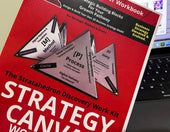
Is Your Strategy Still Just a Pile of Notes and Guesswork?
The Creative Business Strategy Canvas™ is the clarity tool I built after hitting that wall one too many times.It’s one page. Visual. Brutal. Honest.
It shows you your business — as it actually is — so you can build what it’s meant to be.
-

Reinventing Rapid Business Growth With The Strategy SuperModels
Enter The World of Business Strategy SuperModels - Redefine and Reinvent
-

Unlock Business Growth with The Growth Pathway Strategy GPS SuperModel
Unlock Business Growth with The Growth Pathway Strategy GPS SuperModel
-

Reimagining & Reinventing Ikigai for Brand Strategy Design Consultants & Strategists
Exploring Brand Strategy Models & Case Studies In Strategy - The Reimagining of the Ikigai Model - The Strategy Super Model Series
-

Exploring Brand Strategy SuperModels & Case Studies in Strategy
-

FlightPath Day 80 of 100: Rhythm Over Hustle - How Founders don’t burn out from work
-

Want to Obtain Better Business Results in 4 Easy Steps? Keep it Simple - Here's A Really Simple Strategy With BIG Impact
-

10 Must-Haves to Master Your Digital Landscape - The Strategy Playbook
Transform Your Business Online With Clearcut Success Strategies In This Strategy Playbook
-

Do You Want to Lose Track of Your ‘Why’ & ‘How’ amongst all of the ‘WTFs’?
You’ll build out your business journey as your “FlightPath” with a close-knit group using the wisdom of your peers for reimagining your perspective, driving your OWN priorities & finding your OWN critical solutions.
-

How to Use Strategy to Improve Brand Awareness - The Brand Strategy Guide
Here's How to Use Strategy to Improve Your Brand Awareness
-

How to Use Strategy to Improve Market Share: What's Really Important?
How Do You Improve Market Share With Strategy?
-

How to Use Strategy to Improve Innovation - Your Innovation Playbook
Understanding the Connection Between Strategy and Innovation
-

How to Use Strategy to Improve Growth - A Definitive Guide
Strategy is an ongoing, dynamic process of Growth
-

10 Rules of a Strategy-Focussed Entrepreneur That Really Matter
What's really important for a strategy-focussed entrepreneur?
-

10 Rules That Really Matter for a Digital-Focussed Enterprise
Here's 10 simple rules to see if you are a digital-focussed business.
-

10 Invaluable Strategic Business Insights for Today’s Highly Competitive Business Environment.
10 invaluable insights for today’s highly competitive business environment using The Art of War
-

The Strategic Planning Success Blueprint: Navigating the Complex World of Planning With The Strategic Planning Checklist
-

The Annual Strategic Planning Panic Season Has Begun! Ditch the Drama, Embrace the Plan: Less Zigging, More Winning!
Strategic Planning Panic Season. Ditch the Drama, Embrace the Plan: Less Zigging, More Winning!
-

Unlock Your Business Brand Secrets: Master Your Brand & Strategy with the Strategystorming Sprint.
Don't let market disruptions steer you off course; take the helm of your business with unwavering confidence by mastering the art of strategic planning. This is your roadmap to not just surviving but thriving in today's volatile business landscape.
-

Can AI make you MORE Creative, Curious, Innovative AND more strategic? Yes or no?
Can AI make you MORE Creative, Curious, Innovative AND more strategic? Yes or no?
What if it could?
-

What You Think You Already May Know About Cognitive Biases...May Be Wrong
-

A Good Strategic Thinker And A BETTER Strategic Thinker - What's The Difference?
Improve your strategic thinking skills and increase your growth potential.
-

Good Strategy vs Bad Strategy. 5 Simple Symptoms To Identify a Really Bad Strategy.
What are the symptoms and signals that can help diagnose a potentially Good Strategy vs an ineffective Bad strategy?
-

Why Your Strategy Must Not Become A To Do List - The Only 5 Strategic Questions You Cannot Exist Without
By taking the time to answer these questions, you can develop a clear understanding of your company's purpose, its big idea, and how you're going to deliver value to your customers. This will help you to stay focused and on track as you build your business.
-

IMPACT: What would you actually do if you had more of it for your business?
Here's how to find and start to build your impact that lasts with digital strategy
-

The Business Top Gun's Playbook: Harnessing Speed of Strategy and Strategic Direction for Navigation for Impact
-

Which 4 Critical Components You Might Be Missing With Your Strategy - Here's How to Make Your Strategy Quicker, Cheaper & Easier
Is Your Strategy Too Hard? Here's How to Make Your Strategy easier to create, implement & execute without breaking a sweat
-

Strategystorming For Your Future: How Can Reinventing Strategy Help Future-Proof Your Business?
The Future May Be Uncertain, But You Don't Need To Be.
Strategystorming is a powerful tool for achieving success and creating a brighter future. By taking control of your destiny and developing effective strategies, you can overcome any obstacle and achieve your goals, no matter how big or small. -

The Power Of The Prompt - The Strategic Look At Artificial Intelligence Alignment & Business
-

Do You Have A Brand Plan? Here's how to Rethink & Stack the odds and start winning with a brand strategy
-

The 5 Key Strategic Factors You Need To Consider to Integrating AI into your Business Now. Here's How To Get Started to Integrate AI Effectively Into Your Business
5 Key Strategic Factors You Need To Consider In Integrating AI into your Business
What would happen if 80% of what you do is commoditized into the same thing that everyone else is doing? If you can no longer compete on price, and everything is now a commodity, what would you do? How can you accelerate your business while everything is accelerating around you?
-

What's Good Strategy or Bad Strategy? Fighting Fires Is No Longer a Startup Badge of Honour. We need to Reinvent How We Think About Strategy For Startups.
What's Good Strategy or Bad Strategy? Fighting Fires Is No Longer a Startup Badge of Honour. We need to Reinvent How We Think About Strategy For Startups and Smart Strategy for Business.
-

Sometimes we can be extremely surprised at how 'strategic' some things are when we compare it to other things. Here's a case in point.
Here's a case in point about how to get epic things done...strategically - without trying that hard.
-

Anyone can start a business, but can you finish one? Can you get yours to the finish line without a strategy?
Anyone can start a business, but it takes a special skill to finish one - strategy builds a business built to last. Are you building your business to last? It’s not a map, not a business model, not a SWOT, not a business plan, not a 1-page Marketing Plan; it's your strategy operating system that defines the difference.
-

Strategy is about change, and we are all architects of change with our strategic thinking
You're In The Business of Change. You Just Don't Know It...Yet.
What does it take to see Change?
How do we adapt change and think more strategically in the solutions that we deliver, and want to deliver?
-

Why being agile doesn’t save a small business? It’s more about your strategic thinking.
The solution to being agile is more about strategy and your strategic thinking ability
-

The Strategystorming Strategy Studio & Shop Launch Event Speakers Summary
It's strategic clarity & #certainty to help you know how to craft a better strategy, and use strategic & tactical tools for profitable growth and a superior ROI by leveraging the power of your brand.
-

The True Power of Reinvention for Business & Rethinking How We Create Remarkable, Winning Strategies - The Strategystorming Strategy Studio & Shop Launch
-

The Truth About What You Should Be Focussing More On in Your Business - Hint: It's 99% invisible
We don't investigate fully how our customers and audience are thinking - we simply gloss over what we think they need. We rarely feel that we 'need' a strategy to enhance what we're doing to drive profitability and how to win - or that it's something that only big companies have to do to please their corporate rulers. And, seldom do we use any systems to create better efficiencies.
-

How Easy Is It To Sacrifice Tomorrow for Today, Without Even Knowing It? Are You A Slave To The Now Because of Your Strategy in Business?
How Easy Is It To Sacrifice Tomorrow for Today, Without Even Knowing It? Are You A Slave To The Now Because of Your Strategy in Business?
-
![#SmartStrategy [Designing Your Strategy For Business] - Strategystorming - The Strategy Studio & Shop for Strategic Thinkers](//strategystorming.co/cdn/shop/articles/smartstrategy-designing-your-strategy-for-business-256943.jpg?v=1693515536&width=170)
#SmartStrategy [Designing Your Strategy For Business]
Strategy is often what you need to do, but also what you don't need to do. It tells you what you see, but also what you don’t see.
-

Is Bigger All There Is in Business? What does the word GROWTH actually mean for GROWING a business?
If only we could grow more, if only we could scale more, if only we could...
-

Is 'Bigger' All There Is? Reinventing & Rethinking Your Business With Strategy
Strategystorming is the new thinking place where we become better strategic thinkers, by applying strategy here and now, sharing what strategy is for business, and how best to realise it and craft it into remarkable experiences.
-

Do You Know The Biggest Reasons Why a Business Fails? It's Not Because of Tech & Creativity
Why does a business fail, and what can you do about it?
Planning & #strategy is not a "to-do list"
It's not even a list of goals you want to achieve, or "what do you want to become in 2022?" (are you a flower? 😂)
-

What will it take for things to return to business as usual?
It's not business as usual anymore. The Easy Strategy Lab is where we find out how to Reinvent & Reimagine & Rethink business.
We are back with a Strategystorming Show on the 4 greatest myths about strategy, change & reinvention - the misconceptions and outdated assumptions that might be killing your efforts or the efforts of your clients today.
-

Strategy Expeditions for Reinvention, Growth & Performance by Strategystorming - The Strategy Mastery Training Course Workshop
What's Creative Intelligence & Strategic Innovation?Learning strategy and implementation with creative tools and storytelling.Unleash the potential within your business or clients to solve your unique business challenges and create dynamic resilient futures.Meet our Creative Intelligence and Strategic Innovation course - Strategy Mastery Training.
It's education, but not as you know it.
It's a workshop Expedition - a Strategy Expedition to get you to your destination... and back, learning, creating, understanding and crafting your ultimate strategy of resilience & success.

![The Entrepreneur Journey is Broken? [Part 1] - Strategystorming - The Strategy Studio & Shop for Strategic Thinkers](http://strategystorming.co/cdn/shop/articles/the-entrepreneur-journey-is-broken-part-1-590109.webp?v=1701206679&width=170)













































![#SmartStrategy [Designing Your Strategy For Business] - Strategystorming - The Strategy Studio & Shop for Strategic Thinkers](http://strategystorming.co/cdn/shop/articles/smartstrategy-designing-your-strategy-for-business-256943.jpg?v=1693515536&width=170)




